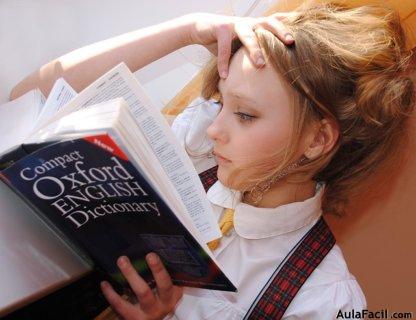What are they doing?
1.- Look at the following pictures. What are they doing?
 |  | |
 |  |
(En todos los ejercicios, para ver la solución hacer doble click en el texto; un click vuelve a posición original)
Clean / Read / Think / Laugh

2.- Important Verbs (II)
2.a. Listen, repeat & learn!
[Objeto Flash Eliminado] Sonido
Make (Hacer)
Run (Correr)
Love (Amar/Querer)
Travel (Viajar)
Smile (Sonreír)
Get (Coger)
Sit (Sentarse)
Believe (Creer)
2.b. Put the letters into the correct order to make verbs.

2.c. How many syllables do the verbs have? 1 or 2? Put them into the correct category. Listen again if necessary.
Make / Run / Love / Travel / Smile / Get / Sit / Believe

2.d. Which of the following one and two syllable verbs end in consonant, vowel, consonant? (¿Cuáles de los verbos acaban en consonante, vocal, consonante?)
Make / Travel / Run / Sit / Get

3.- Ginger arrives at the park where Duke is waiting

Ginger: Hi Duke! I’m here!
Duke: Hi Ginger!
Ginger: Where’s Foxy?
Duke: She’s not coming. She’s making a cake for her mum’s birthday.
Ginger: Yum! I love cake. What about Tina? Where’s Tina?
Duke: She’s running with the ball over there.
Ginger: Oh, yes, there she is.
Duke: Where’s Tom?
Ginger: He’s travelling to his grandma’s house today.
Duke: That’s a shame.
Ginger: Where’s Frog?
Duke: He’s sitting on the bench talking to Tina.
Ginger: Oh yes, so he is!

3.a. What are they doing? Match the people to what they are doing.
He’s sitting on the bench / She’s making a cake / He’s travelling
She’s running

3.b. True or False. Correct the false statements.


4.- Present Continuous (II)
In the previous lesson, we looked at how to form the –ing (gerund) form of regular verbs. We are now going to look at how to form the –ing form with irregular verbs.

If the verb ends in "e", remove the "e" and add "ing", for example, write - writing.
If the verb only has one or two syllable and it end in consonant, vowel, consonant – you have to double the last consonant, for example, run - running.
Si el verbo acaba en “e”, quita el “e” y añade “ing”, por ejemplo, write – writing.
Si el verbo tiene una o dos silabas y acaba en "consonante, vocal, consonante", tienes que doblar la ultima consonante, por ejemplo, run –- running.
4.a. Put the following verbs into the gerund form.

4.b. Put the following words in order to make questions.

4.c. Answer the above questions with your own answers.

